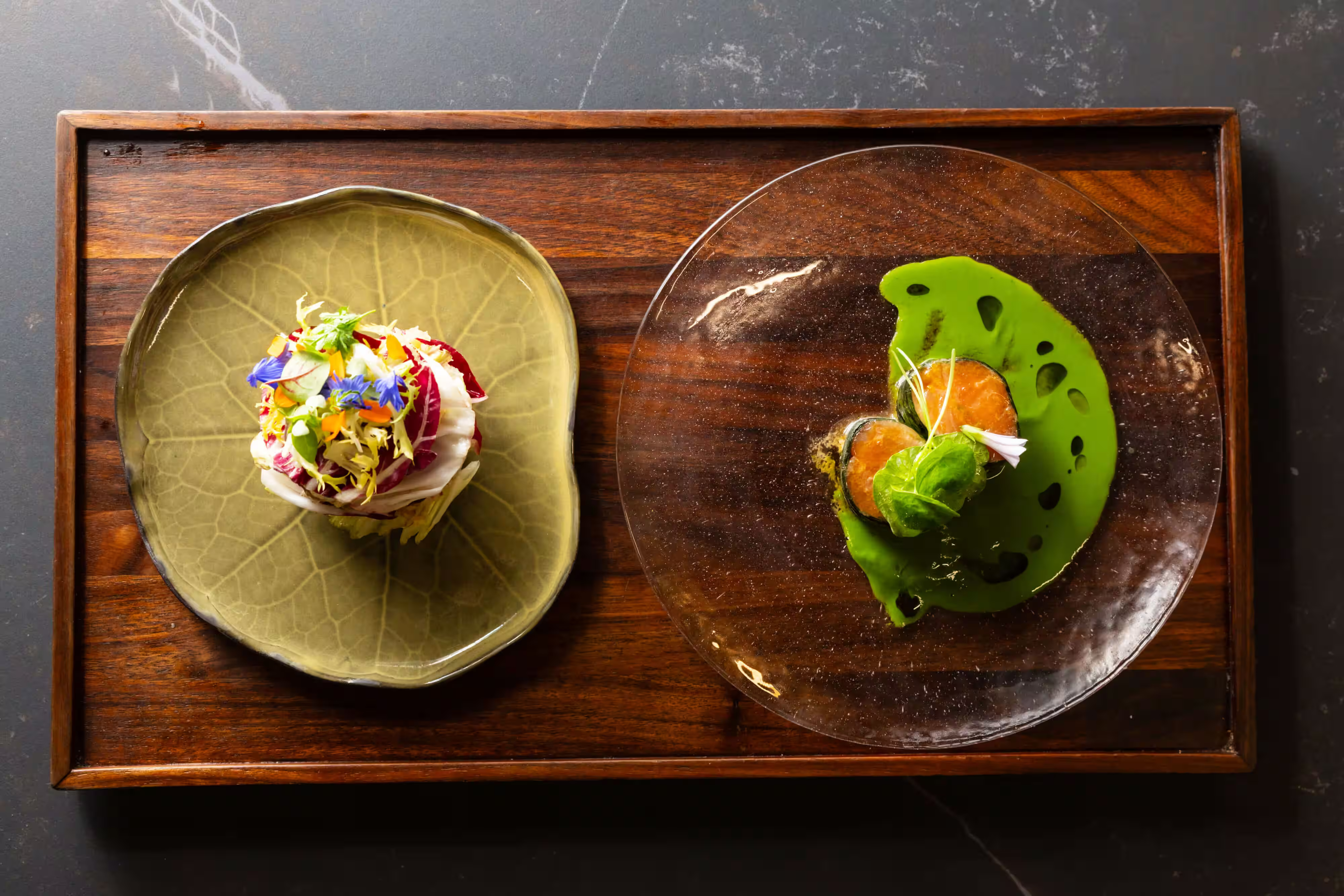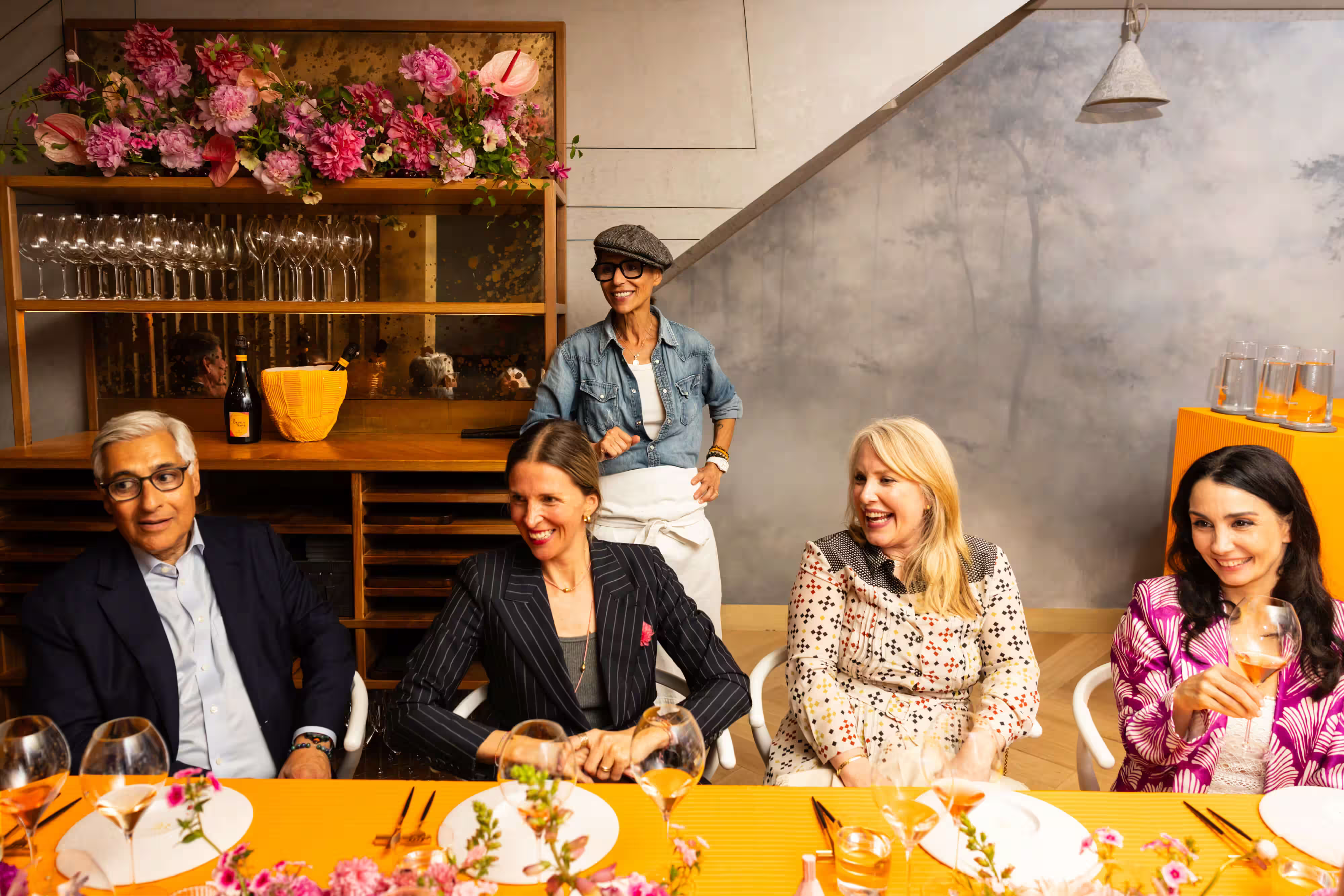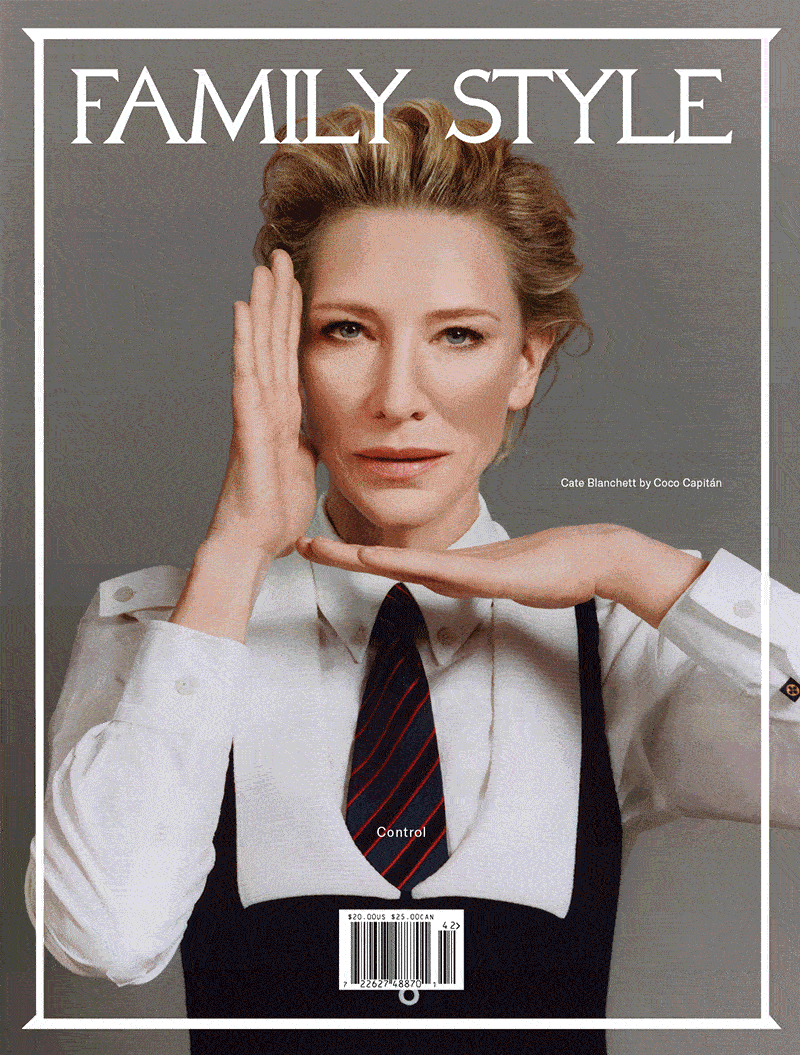
Photography by Drew Altizer. Image courtesy of Veuve Clicquot.
It’s the twilight of June, and San Francisco is in bloom: dogwood trees heavy with blossoms. Hydrangeas spill out in front of Victorians and patches of cornflowers and carnations peek out from behind fences. But dahlias might be the city’s crown jewel. Ombre and sun-spangled, the early summer sun coaxes their petals out, and sends a wash of color over Golden Gate Park and into city yards. On days like this, when the clouds part long enough for the sun to warm the foliage, the air is so sweet you can almost taste it. At Atelier Crenn—on Fillmore Street, seven blocks from the densely forested Presidio—you can.
As I enter the three-Michelin-starred restaurant helmed by Dominique Crenn, I run my hands across blush and crimson peonies and dahlias before I find my seat at a textured, pale-pink table, inspired by Italian artist Paola Paronetto. It isn’t long before my glass is filled with a strawberry-hued rosé. The tablescape is the flower child of the chef’s team and Veuve Clicquot; the dinner is a celebration of the maison’s latest vintage, La Grande Dame Rosé 2015.

Dominique Crenn and table. Photography by Drew Altizer. Image courtesy of Veuve Clicquot.
“The world is beautiful,” says Crenn, as she addresses a lucky set of San Franciscans including landscape artist Lily Kwong, interior designer Jay Jeffers, Tamara Rojo of the San Francisco Ballet, and Denise Hale, San Francisco’s own La Grande Dame, decked out in sparkling black coat and a large necklace of precious gems. Also in the mix are New Yorkers, like myself and Dan Rubinstein of The Grand Tourist. And while this celebration is one-of-a-kind in its presentation, it will be repurposed as 6 courses and 3 champagne pairings at Petit Crenn from July 12 and 13 for the community to experience.
Tonight, Crenn flutters from guest to guest before landing in front of us all. She speaks like a romantic with an easy charm and an effortless, energetic presence—balanced with the ease of a chef who has spent many rigorous and exacting hours of her life with a steady hand in the kitchen. She is dressed in a crisp, white tank-top, denim button-down, a gray pageboy over a ponytail, thick black-rimmed eyeglasses, a stack of beaded bracelets and a chunky watch, and white leather Dior star sneakers. She gestures to the Veuve Clicquot team, then her new wife, the actress and producer Maria Bello. “Make sure that when you partner with someone, it makes sense, and it's really speaking to you,” she says with a big smile.
.avif)
Photography by Drew Altizer. Image courtesy of Veuve Clicquot.
Soon, a small, waxy cream-colored ball with a dot of black-currant liqueur gel appears on a wooden slab in front of us. The edible cocktail, Kir Breton, is a specialty of Brittany, France where Crenn is from. We are instructed to place it in our mouths—no need to bite down, the shell of cocoa butter caves in, and out bursts hard cider. Next up, a tarragon-green mousse replica of a strawberry resting on a clear and bubble-like plate filled with marigold’s from the chef’s garden. I scoop the faux fruit’s creamy, dimpled surface up with my spoon and discover textured bits of pickled anchovy and preserved lemon. Raw and grilled oysters follow. Then crab, avocado, and caviar bites, which come out with a savory, juicy broth made from crab shells, lemon grass, coconut oil, and tomato. Every texture is creamy and umami-packed to the point that the lack of meat and diary becomes an afterthought.
The dish of honor is tartlet of caviar and beets from Crenn’s regenerative farm Bleu Belle. The earthy, savory, and rich tart arrives topped with creme fraiche, dashi gelee, meyer lemon, and gold flakes, all atop a koshihikari rice-tart shell. It is inspired directly by La Grande Dame Rosé 2015 and its Maison’s namesake Madame Clicquot, a trailblazer who became one of the first female entrepreneurs and the first to blend red wine into white at the dawn of the 19th century after becoming a widow at 27. “She took over an empire that was not really an empire and started to build something magnificent. She was the first one to do a vintage champagne,” Crenn emphasizes. “[She was] a woman with maybe not a lot of experience but the willingness and the creativity and the love of doing something beautiful—that speaks to me.” Her spirit reverberates in the energy of Chef Crenn as well as the local nonprofit La Cocina that supports women of color in the food and beverage industry, which the evening benefits.
.avif)
Photography by Drew Altizer. Image courtesy of Veuve Clicquot.
In between bites, I take sips of the effervescent rosé of honor, and violets and stone fruit mingle with light, aromatic notes. There are prawns and sea urchins from Santa Barbara and Monterey Bay abalone. Every course is sun kissed and salty like the Pacific Coast and displayed on dishes that recall ocean beds and forest floors. The final part of the menu begins with a compressed sugar-bee apple with shiso atop a bed of shaved ice, a pina colada cupcake in an edible rice-paper wrapper, thai salad, and pine-cone ice cream in a delicate chocolate cone—all paired with Veuve Clicquot.
As I roll over the local flavors in my mouth, I can’t help but think of the San Francisco of my college years as an old lover: memory drenched, unchanging, and out of focus. It is an impenetrable pit wedged between fruit, ripe with promises of forever and dreams of Victorian flats and coyotes. I used to run around with flowers in my hair. As I return, I forget why I ever left. It is a city of hopeless romantics like Crenn, who imagine possibilities behind every twist and turn, every hill and valley. There’s time to get lost here. There is also a harshness, the wind, the high rent, vacant storefronts: drawn out in the news so that it drowns out the beauty. Yet the city is unwavering, a small and confrontational grid—a resilience embodied by the people, present in their voices when they say: “We’re not leaving, this is our home.”

Photography by Drew Altizer. Image courtesy of Veuve Clicquot.
I return to the present and savor the incredibly fresh and creatively prepared seafood, holding each bite in my mouth a moment longer. I also notice the flowers and foliage. Shiso leaf raw, battered and fried, or wrapped around local fish. Nasturtium microgreens, sweet alyssum, pea shoots, baby-gem lettuce, orange and blue and fuchsia-hued flowers. One hundred-something miles away in Jackson, I can’t help but imagine Bleu Belle bursting at its seams with rows of lavender, fiery marigolds, spring chicory, clusters of sweet williams, borage, and wild fennel.
“San Francisco is one of the most beautiful cities in America. There are beautiful people, a beautiful landscape,” says Crenn. “I know there are a lot of bad things in the media, but we are here to stay, and as a woman I'm here to make the city better every day—with Champagne.”








.avif)
.avif)




.avif)

